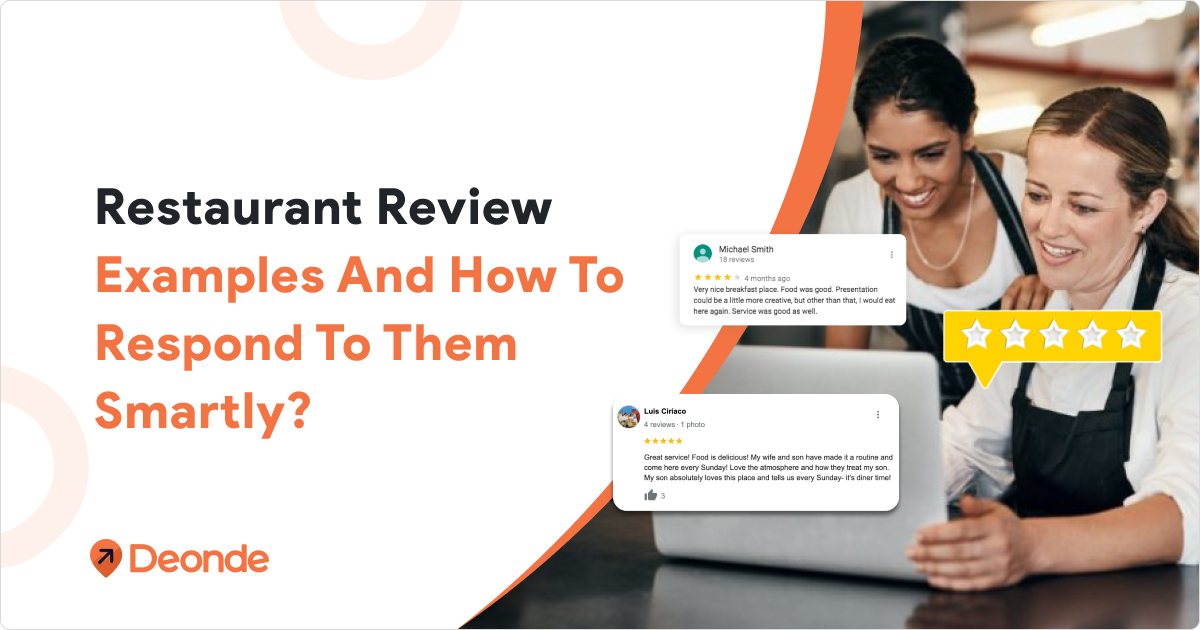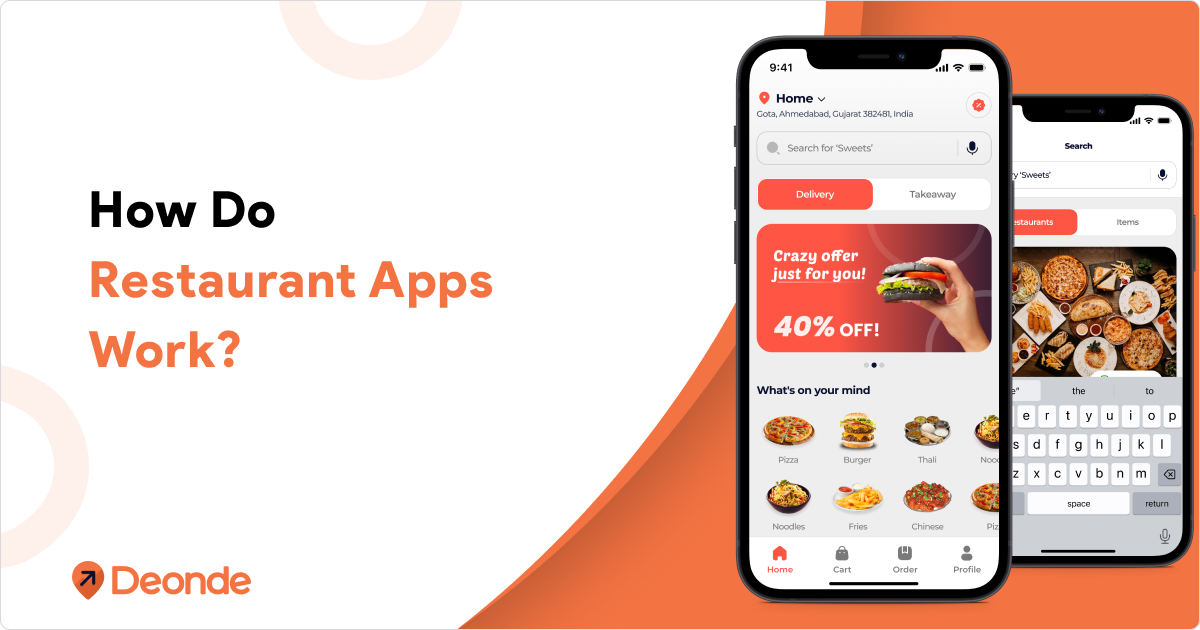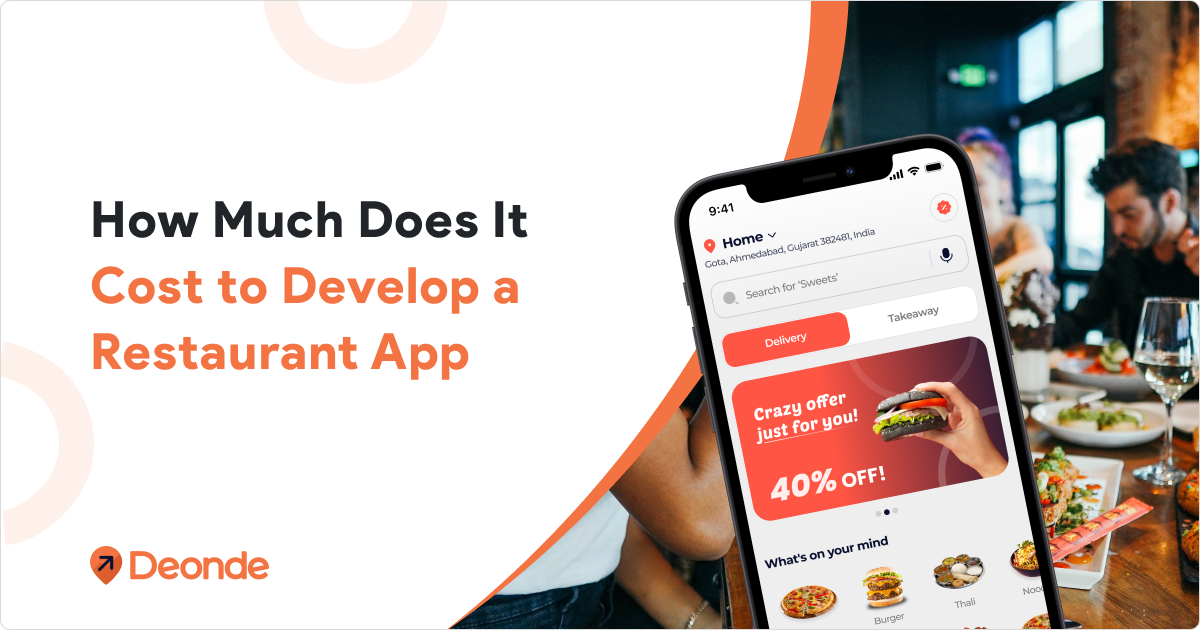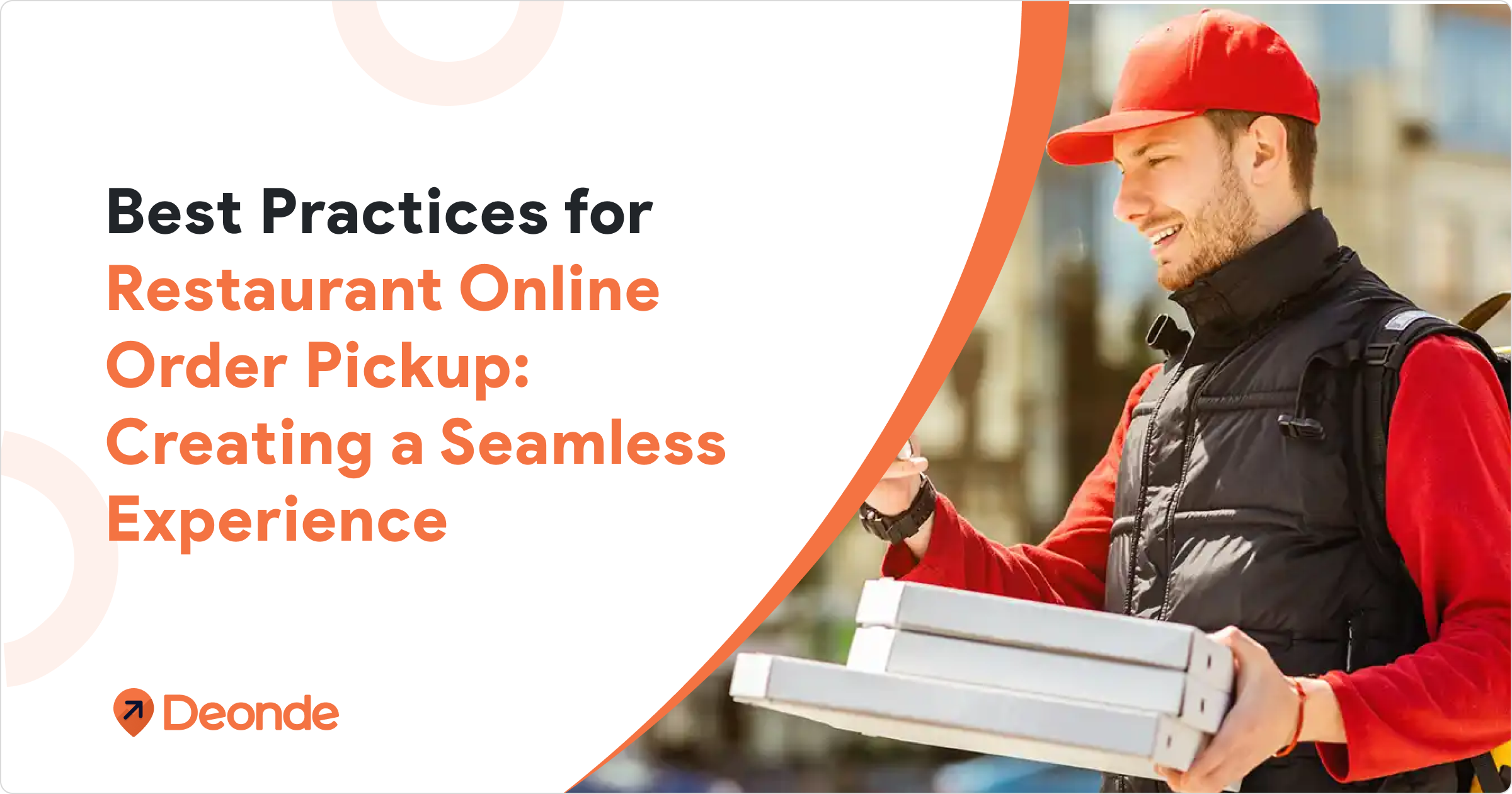Why Do Restaurant Reviews Matter?
Even one positive review can significantly improve your restaurant’s online presence and boost foot traffic.
But a bad one can make or break your business.
This is why it’s always like walking on the fence when you ask your customers to rate your services. The good ones can do wonders while the bad ones can sink your ship.
According to recent research, a whopping 92% of customers read at least 2 reviews before forming an opinion about a local business.
Hence, it’s safe to assume that, besides friends and family, online restaurant reviews have now become a major influence, affecting how people eat or order food online.
Online reviews have grown in importance to the point that 95% of customers read them, with 88% placing equal or more trust in them than personal recommendations.
So, in this blog, we’ve explored some excellent restaurant review examples and provided tips to respond to them in a way that manages your restaurant’s reputation and boosts customer retention.
How To Encourage Customers To Leave Reviews

From a business perspective, it is important to encourage your customers to drop meaningful reviews.
Restaurant reviews from customers are more than just feedback—they’re about testing the waters, determining what’s working in your restaurant business, and identifying what needs improvement.
Here are some strategies you can implement in your restaurant businesses to encourage meaningful restaurant reviews:
1. Simplify The Process
Make it incredibly easy for customers to leave reviews. Provide direct links or QR codes to minimize the number of steps required.
The fewer clicks, the more likely your customers are to follow through.
2. Ask At The Right Time
When it comes to restaurant reviews, timing is everything
Ask for reviews immediately after a positive interaction, such as after a delicious meal or when they’re paying the bill. For on-demand deliveries, consider sending review reminders at least 20 minutes after the order has been delivered.
Consider a follow-up email or text the same day, while their experience is still fresh.
3. Highlight Review Platforms
Clearly display the platforms where you want reviews, such as Google, Yelp, or TripAdvisor.
4. Personalize The Request
For in-house dining customers, train your staff to personally ask for reviews, emphasizing the value of their feedback.
Use personalized language, such as, “We’d love to hear about your experience today.”
5. Offer Incentives Strategically
Consider offering small incentives, like a discount on their next visit to your restaurant, for leaving a review.
Ensure incentives comply with your restaurant guidelines and don’t come across as a restaurant that buys customer reviews.
6. Use Visual Reminders
Place signage in your restaurant reminding customers to leave reviews. For digital reviews, use tools like push notifications to remind customers to leave reviews.
7. Leverage Social Media
Post regularly on social media, encouraging customers to share their experiences and leave reviews.
You can also run contests or giveaways that require participants to leave a review.
How To Improve Restaurant Reviews And Ratings?
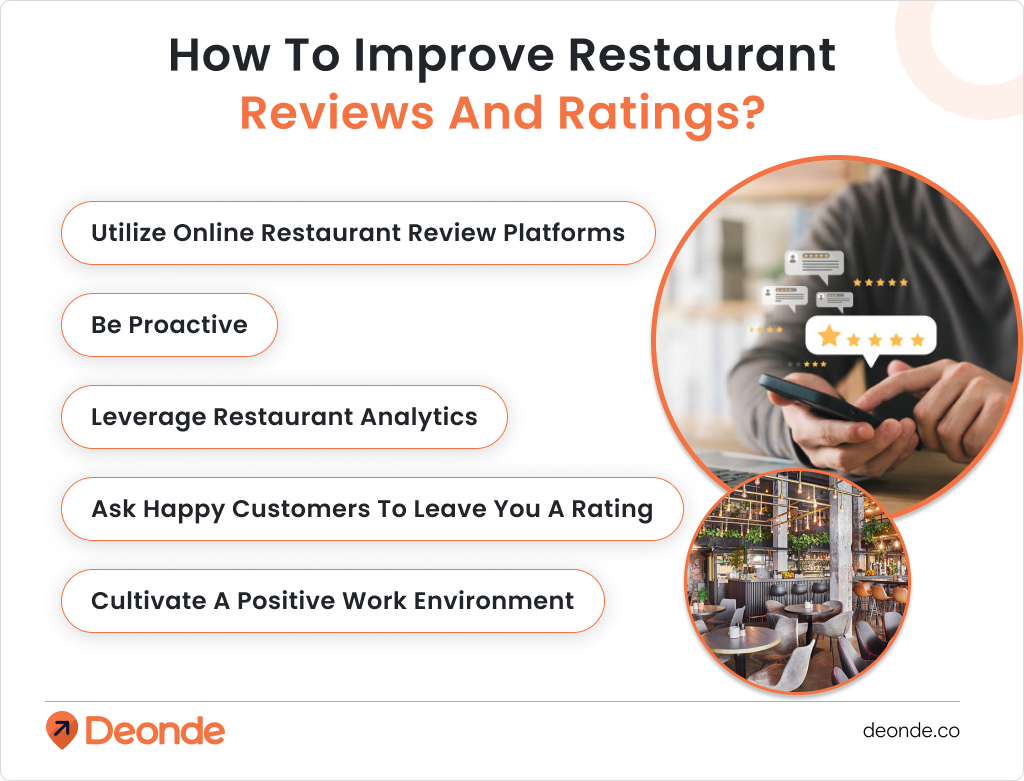
Today, restaurant reviews are everything.
Positive reviews drive customer acquisition and foster loyalty, while negative reviews, if not handled correctly, can deter potential diners.
So, here’s a comprehensive approach to improve your restaurant reviews and ratings, focusing on strategic restaurant reputation management for restaurants.
1. Utilize Online Restaurant Review Platforms
First things first, make sure your restaurant is easy to find online.
Be active in places like Google, Facebook, and Instagram.
Google reviews are probably going to be where you will drive most of your traction, though.
Once you make yourself known on these websites, you’ll be one step closer to obtaining ratings from your most loyal customers.
Show your patrons that their opinions matter to you by actively liking and replying to the comments they leave online. Interacting regularly with your customers can also help encourage others to voice their thoughts and opinions on your restaurant.
Doing so will help you build a community and encourage more reviews
2. Be Proactive
Make your customers feel special from the minute they order food online or enter your restaurant.
Train your staff to know what customers need before they ask. If something goes wrong, fix it quickly and nicely. Apologize and offer something to make up for the negative experience.
Also, don’t wait for a negative review to fix your restaurant service.
By consistently delivering exceptional service, you prevent negative reviews, set a benchmark for quality, and distinguish yourself from the competition.
3. Leverage Restaurant Analytics
When interpreted correctly, restaurant analytics can do wonders for the success of your business.
The data you collect through your restaurant management platform can provide valuable insight into customer preferences and behavior. Identify popular menu items, peak hours, and customer demographics to optimize your offerings and operations.
Use this data to make informed decisions that enhance the customer experience, leading to more positive restaurant reviews.
4. Ask Happy Customers To Leave You A Rating
As a restaurant owner or manager, make it a point to connect with diners throughout the day.
If you sense they’ve enjoyed their meal and service, don’t hesitate to ask them to leave a quick rating on your Facebook page or Google My Business profile.
Even a simple five-star rating significantly boosts your online presence. To guide them, suggest they comment on the atmosphere, a new menu item, or the service they received.
If you’re struggling to get reviews, consider offering a small incentive, like a discount on their next bill, for showing their review.
A strong base of positive reviews can easily offset the occasional negative one.
When you do receive negative feedback, treat it as a learning opportunity; investigate the issue and train your staff to prevent future occurrences.
While word-of-mouth is valuable, online reviews are essential in today’s digital world, where potential customers rely on search engines to discover and evaluate your restaurant.
5. Cultivate A Positive Work Environment
Remember, reviews aren’t always from customers. Current and former employees can also contribute to online reviews.
Negative reviews from disgruntled staff can significantly damage your online reputation.
Ensure your restaurant adheres to all labor laws and considers perks like tip pools to foster a positive work environment.
Happy employees provide better service, which builds customer trust and loyalty.
Well-treated staff are also more likely to go the extra mile, creating exceptional dining experiences.
Restaurant Review Examples
Let’s sample some restaurant reviews from across the web and understand why these reviews are contributing to the restaurant brand’s value.
Hope these inspire you and can help you guide your customers to leave thoughtful reviews:
1. The Rustic Spoon, USA
Customer Review:
The Rustic Spoon has redefined farm-to-table dining for me. Their heirloom tomato salad burst with flavors I didn’t know tomatoes could have!
The locally sourced ribeye was cooked to perfection – a beautiful medium-rare that melted in my mouth.
But the showstopper was their lavender honey ice cream; it’s a delicate balance of floral and sweet that I’m still dreaming about.
Chef Maria’s commitment to showcasing local ingredients shines through in every dish. A must-visit for food lovers!”
Review Analysis:
This positive customer review excels at providing specific details about dishes, painting a
Story for those reading it online. The review also conveys an emotional connection to the food, which is very convincing—anyone reading this will be tempted to try the mentioned dishes.
To sum up, this review is a good example of how good customer service can lead to happy, emotionally charged positive reviews.
2. Dominos Pizza
Customer Review:
Very tasty pizza in Dominos. Base is superb, crunchy. Veg overload is cheesy and very tasty. Breadstick also best.”
Review Analysis:
The review is short and to the point, making it easy to read and understand. This is a common style for quick reviews, especially on platforms where brevity is valued.
The reviewer uses sensory details like “crunchy” and “cheesy,” which help readers visualize and imagine the food. This helps paint a picture of the food, making the review more effective.
3. McDonald’s
Customer Review:
“McD is always a good place to hang out with friends but the only problem is they do not offer good wide range of food for vegetarians.
In here you have the McCafe too which is really very good and maintains the very standards of MCD”
Review Analysis:
This review is fair, saying both good and bad things. The person likes that McDonald’s is a fun place to hang out, but they wish there were more vegetarian choices.
They also said the McCafe is good. Because it’s a mix of praise and complaints, it feels real.
This review might make vegetarians think about going, and it could make McDonald’s think about adding more vegetarian food.
4. Taco Bell
Customer Review:
“Love the Taco Bell delicious taste and yummy new mild taco is best taco loved it.
New mild taco is full of cheese and spices it is very delicious you must try it and shake is awesome it is very thick and yummy and the chocolate mouse is literally lit like the way how they are serving unlimited cold drinks”
Review Analysis:
The sensory details of the comment make it an effective customer review. By also noting the ‘unlimited cold drinks,’ the reviewer has illustrated how a positive service experience can enhance overall satisfaction.
The reviewer’s enthusiastic tone and direct recommendation (‘you must try it’) showcase how authentic excitement can drive customer interest and action.
For Taco Bell, this type of feedback is invaluable, providing clear, positive signals that can inform marketing strategies and potentially guide menu innovations.
This review underscores the importance of understanding and leveraging customer feedback, even in its most casual form, to foster restaurant success.”
5. Bartaco, USA
Customer Review:
“Our first time at Bartaco was awesome! We usually go to El Santo but wanted to switch it up! It didn’t disappoint. All the tacos were delicious.
Highly recommend the birria tacos, Short rib tacos, street corn, and duck tacos. The fresh-squeezed juices were good too! We will definitely be back again!
Review Analysis:
The reviewer’s initial enthusiasm, “Our first time at Bartaco was awesome!”, immediately sets a positive tone.
Notably, they contextualize their visit by mentioning a switch from a competitor, “El Santo,” demonstrating Bartaco’s appeal in a competitive market. The review’s strength lies in its specific menu recommendations, which offer valuable guidance to potential diners.
Ultimately, this review underscores Bartaco’s success in delivering a memorable first impression, fostering customer retention, and providing clear, actionable feedback for both the restaurant and its prospective patrons.
Sample Restaurant Reviews and Responses
To better understand how to address customer feedback, we’ve compiled sample restaurant reviews covering a range of experiences.
Alongside each review, you’ll find strategies for crafting thoughtful and impactful responses that can enhance customer satisfaction and improve your restaurant’s image.
Review 1:
“The food was delicious but the service was excruciatingly slow. Waited 45 minutes for our appetizers. Beautiful ambiance though!”
Response:
“Thank you for your feedback. We’re pleased you enjoyed our food and atmosphere. We apologize for the slow service and are addressing this with additional staff training.
We hope you’ll give us another chance to provide a faster experience next time.”
Review 2:
“Overpriced and underwhelming. $32 for a tiny portion of pasta that tasted like it came from a box.”
Response:
“We’re sorry to hear your experience didn’t meet expectations. Our pasta is made fresh daily, and we aim to provide value with quality ingredients.
We’d appreciate the opportunity to make this right – please contact our manager directly so we can address your concerns.”
Review 3:
“Five stars! The chef’s tasting menu was exceptional, and the wine pairings were perfect. Worth every penny for a special occasion.”
Response:
“We’re thrilled you enjoyed your experience! Our chef will be delighted to hear your feedback on the tasting menu.
Thank you for choosing us for your special occasion, and we look forward to welcoming you back soon.“
Review 4:
“Great food, but the noise level made conversation impossible. Consider some sound dampening.”
Response:
“Thank you for your honest feedback. We’re glad you enjoyed the food and we’re sorry about the noise issues.
We’re currently exploring acoustic solutions to create a more comfortable dining environment.
We appreciate your suggestion and hope to provide a better experience on your next visit.”
Review 5:
“Fantastic vegetarian options! The first time I didn’t feel like an afterthought at a steakhouse. Our server Alex was knowledgeable and attentive.”
Response:
“Thank you for your kind words! We’re proud of our vegetarian menu and work hard to ensure all diners have excellent options.
We’ll pass your compliments to Alex – he’ll be delighted to hear it. We hope to see you again soon!”
How To Respond To Restaurant Reviews Smartly?
Responding to restaurant reviews is a smart way to build customer loyalty.
However, this outcome hinges on the way you choose to respond. Your responses should align with your restaurant’s brand reputation and provide value to the customers who have taken the time to review your services.
Here’s a strategic roadmap of how to respond to restaurant reviews smartly:
Respond To All Reviews
Don’t be that restaurant that only responds to positive restaurant reviews and ignores the negative ones. Maintain brand integrity by addressing both positive and negative feedback.
Personalize Your Response
Begin by addressing reviewers by name and referencing specific details from their feedback. This shows that you’ve genuinely read and considered their comments, rather than resorting to generic responses.
Express Gratitude
Whether the review is positive or negative, always thank the reviewer for taking the time to share their experience. This demonstrates your appreciation for their feedback and your commitment to customer satisfaction.
Address Concerns Proactively
When a review raises specific concerns about your restaurant’s services, respond with clear and actionable solutions. This shows to the people reading your restaurant reviews that you’re not just listening, but actively seeking to improve for maximum customer satisfaction.Marketing
Encourage Further Dialogue
Especially for negative restaurant reviews, consider inviting the customer to connect with you offline. This demonstrates a willingness to go above and beyond to resolve their issues. It shows that you care about your customers and are willing to take accountability for your mistakes.
Leverage Online Review Management Tools
Use AI tools to streamline your response process, especially for frequently asked questions. However, remember to always personalize your replies to maintain your brand’s unique voice and personality.
Maintain Professionalism
Even when faced with unfair or overly critical reviews that aren’t entirely true, maintain a professional and courteous tone. Avoid engaging in arguments or becoming defensive.
Set Realistic Expectations
Avoid making promises that you cannot keep. Be honest and transparent about what you can offer to resolve any issues.
By implementing these strategies, you can transform restaurant reviews into valuable opportunities to build customer loyalty and enhance your restaurant’s reputation.
How To Use A Restaurant Review Management System
Finding it difficult to manage reviews online?
Here’s how Deonde’s restaurant management suite can help you manage, track, and respond to customer reviews seamlessly.
Choose The Right Platform
Choosing the perfect review management platform is a crucial decision for restaurant owners. Factors to consider while choosing a restaurant review management software include:
- The platform’s compatibility with different review sites
- Ability to provide in-depth analytics and ease of access
- Whether the platform integrates with other tools your restaurant uses, such as POS systems or customer relationship management (CRM) software.
A comprehensive review management platform should offer a seamless experience, from monitoring reviews to responding and analyzing data.
If you’re looking for something that is easy to use, adaptable, and economical, reach out to us at Deonde and we’re sure you’ll find what you’re looking for in our SaaS-based restaurant food delivery suite.
Implementation And Onboarding
Once you’ve selected the right review management platform, the next step is implementation and onboarding.
This involves integrating the software into your existing systems, training staff on how to use it, and establishing standard operating procedures for review management.
A smooth implementation process ensures that your restaurant can quickly reap the benefits of the software without disruptions to daily operations.
Connect with Deonde if you’re having trouble integrating review management services into your existing POS system.
Streamlining Review Responses
Efficiently responding to reviews is a key aspect of successful review management.
Review management software often includes features that streamline the response process, allowing you to customize and save common responses, set response time goals, and assign responsibilities to specific staff members.
By streamlining review responses, you can maintain consistency in your communication and address customer feedback in a timely and personalized manner.
How To Track Changes In Ratings And Feedback Patterns
Tracking changes in ratings and feedback patterns is essential for understanding the impact of your restaurant’s efforts on customer satisfaction.
Review management software typically includes analytics tools that enable you to track trends over time, identify areas of improvement, and measure the effectiveness of implemented changes. Consider Deonde’s SaaS-based, pre-built restaurant management app for tracking reviews, ratings, and more.
By continuously monitoring changes in ratings and feedback patterns, your restaurant can adapt its strategies to meet evolving customer expectations and preferences.
Summing Up
Cultivating a strong online presence through thoughtful review engagement is no longer optional for restaurants. It’s something you need to do daily.
By responding constructively, you build customer loyalty and gain invaluable insights to refine your services and enhance your reputation.
Ready to transform your customer feedback into tangible growth? Deonde’s specialized restaurant management software can help you streamline your reviews and personalize interactions, giving you the needed edge.
See how Deonde can help you turn reviews into repeat business—talk to us today!
FAQs
1. What Should I Say In Response To A Restaurant Review?
Thank the customer, use their preferred name, and reference specific points they mentioned in their review. In short, be specific and personalize your response.
For positive reviews, express gratitude and invite them back for more.
For negative reviews, acknowledge concerns without defensiveness and apologize sincerely. Close with an invitation to return and experience the changes, offering contact information for further discussion if appropriate.
2. How Do You Respond To A Rude Restaurant Review?
Maintain professionalism regardless of the reviewer’s tone. Thank customers for their reviews, even if they are negative, and address their concerns objectively. Start by apologizing for service failures.
Also, keep your response solution-oriented, outlining specific improvements you’re making. While responding to a rude review, remember that anything you comment on will be read by potential customers. Hence, respond with integrity and make sure your tone reflects your business values.
3. What Should You Avoid In A Restaurant Review Response?
Avoid defensiveness, argumentative language, sarcasm, or condescending tones. Don’t make excuses or shift blame to staff or circumstances.
Never share personal information about employees or customers. Although we’ve provided generic template responses in this blog, only use them as a starting point. As generic responses don’t seem insincere. You must personalize all responses and make sure your replies are in line with the reviewer’s feedback.
4. How Do You Respond To A Fake Restaurant Review?
Make sure you underscore reviews that are fraudulent without being unprofessional.
You can say things like, “We’ve no record of your visit or the incident.”
You can also mention that you take all feedback seriously and invite them to contact you with specific visit details. Lastly, report the suspicious review to the platform with supporting evidence.

